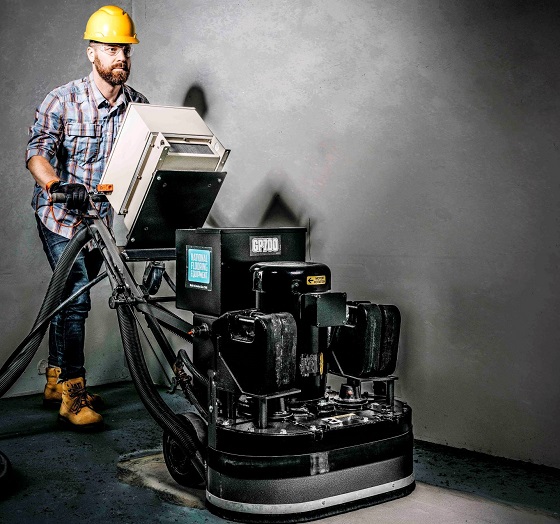Transportation infrastructure is vital to the health of the U.S. economy. Whether it is commuters driving on highways each day or local and international tourists taking aircraft flights, we rely on transport networks to get us from one point to another.
Consistently maintaining this critical infrastructure can be difficult. USA TODAY, for example, reports that over 21% of roads nationwide are in poor condition. People need to travel daily, so how do we effectively repair infrastructure without disrupting day-to-day life?
For large, outdoor applications, proper surface preparation can be critical. Effective surface prep plays an integral role in maintaining critical infrastructure such as highways, bridges, parking structures, and airport runways. These surfaces must be in good condition to ensure the safety of people using them, as well as ensure that each floor has the durability to withstand vehicle and pedestrian traffic, along with differing weather conditions.
While contractors often understand the importance of maintaining these spaces, completing the work without disrupting travel can be challenging. McKinsey & Company estimates that large-scale construction projects take 20% longer than scheduled and finish up to 80% over budget. From experience, these unexpected delays could be caused by factors such as weather delaying work, or a lack of preparation before arriving at the site.
However, sticking to the budget and client deadline is not impossible. By taking the time to plan work effectively and choosing the right tools for the application, contractors can deliver high-quality surface preparation at any scale.
Preparation Is Key
When starting any project, contractors should consider how to meet a client’s expectations while adhering to the outlined deadline and budget. This is particularly important on large sites with regular traffic, because customers often want to limit disruptions as much as possible.
Taking the time to efficiently plan prior to arriving at a jobsite is integral to the surface prep success. By visiting before work begins, contractors can understand the project’s size and scope and the condition of the existing floor, along with its current covering and the client’s specifications.
For example, in large, outdoor applications such as airport runways, highways, or car parks, contractors often need to communicate with the facility’s manager to clear the area of pedestrians and vehicles before commencing work. Some circumstances require an entire site closure for safety reasons, while in other instances, contractors may be able to complete the work in stages to limit any potential disturbance.
For example, repairing the floor in a multi-story parking structure one level at a time could give contractors time to complete the work efficiently — and without closing the entire structure.
It is also important to accurately estimate the project’s timeline if tight deadlines are required, such as when working in high-traffic areas. Sticking to the deadline might mean working in challenging conditions, such as in rain or at night. Plans must ensure that crew members can safely work through different weather conditions, darkness, and high or low temperatures. Contractors need enough time to complete their work without rushing it.
Choosing a Machine
Once a project’s goals and timeline are finalized, contractors can determine what equipment or machinery they require.
Larger projects usually require heavy-duty ride-on scrapers, which have a faster removal rate and are better suited to removing heavy goods like industrial epoxy with aggregate. Walk-behinds may be more suited to applications such as weight-restricted bridge decks, or around tight corners and hard-to-reach areas that a ride-on would have difficulty targeting.

A combination of machines may be necessary when the jobsite has varying levels of surface hardness, thickness, and complexity. For example, a ride-on scraper may be more efficient in removing large areas of material, while a walk-behind scraper may be more effective for precise removal during edge work.
Additionally, achieving the desired surface finish may require different processes. For example, shot blasters can efficiently remove coatings, adhesives, and contaminants from vertical or horizontal surfaces. They can also create a surface texture that improves the adhesion of coatings or to produce a non-slip surface. Scarifiers are useful where more aggressive treatment is necessary, such as removing thick coatings, roughing up smooth surfaces, or levelling uneven surfaces.
Consider which fuels will be most appropriate during the project. In large outdoor spaces, an electricity supply for plug-in machines may not be easily available. Thus, diesel or propane powered machines might offer more freedom.
In any project, safety must be a priority for machinery operators and other contractors at the jobsite. Areas undergoing work should be physically cordoned off to prevent members of the public from entering the site.
During ongoing work, contractors can also select equipment with added safety features to protect workers. For example, some ride-in scrapers feature light curtains to outline the machine’s movement. Choosing a ride-in machine with a positive air pressure cab can also protect an operator by reducing dust inhalation and enabling them to work in different conditions.
Maximizing Uptime
Choosing the right equipment is vital, but learning how to use it effectively is key to maintaining jobsite productivity. By approaching the equipment supplier for training, contractors can understand how to set up and use equipment to increase their productivity and ultimately create a safer working environment.
For instance, setting up the angle and pitch of a blade can impact covering removal rates. In many cases, understanding how to properly angle a blade for the covering could be the difference between quickly removing a coating and struggling to remove anything. It’s important to follow advice regarding maintenance, especially on longer projects, to minimize downtime.
States spend billions each year on infrastructure maintenance to ensure that people can safely and efficiently travel. So, when conducting repairs, laying new coverings, or completing new outdoor projects, contractors should prioritize surface preparation to deliver a surface that will deliver long-lasting strength and durability.
By preparing in advance, selecting the right equipment, and seeking support from experts in the field, contractors can successfully prepare the outdoor infrastructure we use every day.